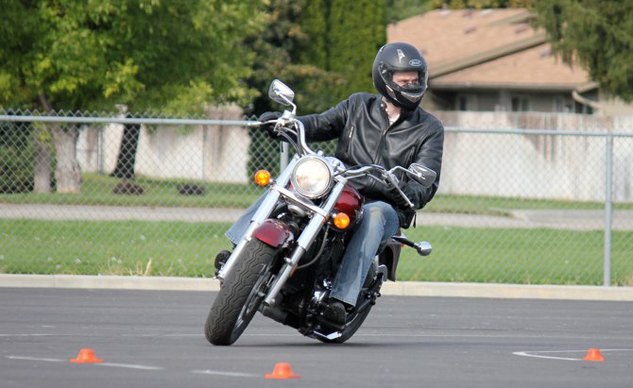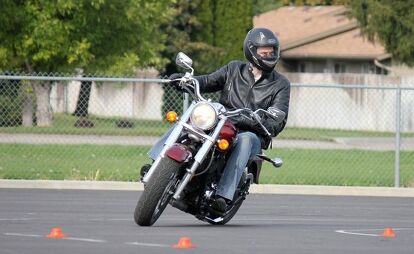Skidmarks - Meet the New Boss
“It’s clear to me that more of us are dying because there are too many people who really shouldn’t ride motorcycles and the industry and advocacy groups do nothing to discourage them.” – Me, “So Why Are we Dying?,” CityBike Magazine, August 2012.
It’s like some kind of media comet with a slightly irregular period. About every three to five years, a bored reporter gets a press release from one safety organization or another describing an increase in motorcycle fatality rates for older riders, and the reporter – who was deployed in an overseas combat zone or maybe just had some kind of head injury so he or she forgot about the last time the story appeared – writes with much gravity about the pressing problem of increased fatalities among older motorcyclists.
The stories follow a time-honored script: sensationalist lead paragraph, some quotes from motorcycle shop owners, a quote from one or two older riders, and then, buried way down around the 12th or 15th paragraph, a short sentence noting that perhaps the increased age of fatalities has something to do with the increased age of the riding population in general.
This is at least a change from the ’80s, when “hyperbikes” were the alleged cause of increased fatalities, or the ’70s, when it was blamed on (I assume) wild-eyed hippies high on The Pot. Luckily for those of us who enjoy riding motorcycles, the American public is pretty tolerant of us engaging in what is inarguably a fantastically risky activity and has eschewed safety-related regulation – helmets and rider training are mandatory in less than half the states.
Is this a good thing? Libertarians may love this kind of freewheeling non-regulation, but I’m not sure it’s a good thing in the long run for motorcyclists. The problem is that fatality and injury rates stubbornly stay high while safety in other passenger vehicles improves. Just wait until every car becomes self-driving (and I think we’re only about a decade away from that), and it’s statistically safer to be in your car than your bathroom. If moto-fatality rates stay the same, almost all traffic deaths will be motorcycle-related, and how long do you think we’ll be able to keep our right to ride? About 12 minutes, I think.
So, what’s the answer? Well, ABS and universal helmet laws will reduce fatalities, but I know a lot of you hate those. Weirdly, there’s more support for tiered licensing than helmet laws, but that would never happen here. Neither will mandatory training, or at least the kind of in-depth training that will have an impact on accident rates.
No! Said the California Highway Patrol. In September, the CHP sent out an “Invitation for Bid” (IFB) for somebody to manage its California Motorcycle Safety Program (CMSP). The MSF’s contract expires January 1, 2015, a program it has been involved with since 1987. In November, the MSF sent out a (kind of pissy) letter explaining why it would not submit a new bid. The CHP (among other things) wants the right to alter curriculum and make other changes to the program with 30 days notice, something the MSF didn’t want to live with. The MSF “cannot administer the CMSP as proposed and remain true to its rigorous standards and strategies for serving the riders,” wrote the MSF’s Rob Gladden. The MSF has abruptly and not-so-gracefully bowed out of rider training.
GONG! Enter the new boss man, founder and Pres-o-dent of Total Control Training, Inc. (TCTI), which won the bid to manage the CMSP for three years (with an option to continue it for two more). His name is Lee Parks, and full disclosure, he’s a friend-like acquaintance of mine. In fact, I met him through Motorcycle.com, when then-Publisher Sean Alexander sent me on a three-day junket with Lee. It was bromance at first sight – we rode on his mini-moto track in his front yard, shot trap in his back yard, and then roadtripped to Arizona, where I took his then-new Total Control Advanced Riding Clinic. There, I learned some great stuff aimed at making me a better, safer street rider.
Now, Lee is a likeable guy and offers a great class for intermediate and advanced riders, but what does he know about teaching noobs? Can he do a better job than the MSF, which for all its flaws has more experience teaching new riders in one corporate pinky than Lee has in his entire body?
Yes, indeedy, says Lee. First, the curriculum will be better. The Total Control Beginner Rider Clinic (TC BRC) classroom portion will be “trained educators teaching in the classroom, not [helping students look] up answers in a book. The current program [where students sit in groups and find answers in the CMSP workbook] devalues the instructor.” Additionally, there will be California-specific material: “Lane-splitting, double-doubles, exhaust systems and emissions, HOV and HOT lanes, insurance. When you’re done, you’re really a big step closer to being ready to ride in California than if you took a generic class.”
The school will deliver the textbook as an e-book before class, a format that allows easier changes than the MSF’s pricey and infrequently revised paper handbooks: “We can immediately implement changes that may reduce fatalities.” Much of the curriculum is based on Idaho’s STAR new-rider program, supplemented with new material from Lee’s research for the second edition of his riding-techniques book, Total Control.
The instructors, Lee told me, will be … instructors, with real enthusiasm for the material and motorcycle safety, and both the instructors and the independent schools that employ them will meet higher standards.
“There are a lot of instructors that shouldn’t be teaching, and a lot of sites that shouldn’t be in business,” Lee told me. “[They] have to understand that, even though they’ve had successful businesses, the program has been a complete disaster as far as fatalities are concerned. If it wasn’t a failure, the CHP wouldn’t have wanted new curriculum.”
These are not words that will soothe the 100-plus owners of schools in California, many of whom struggle to stay in business. Expect a significant number of these sites to close – and a slew of new ones to open. Under the MSF system, ranges were guaranteed monopolies in their service areas (according to Lee), but “we’re free market folks, and I don’t believe in not having competition – you’re not motivated to improve.” And since all the instructors need to be retrained, there may be many RiderCoaches who will fail the TCTI prep course, never again to flatten their arches on a California motorcycle training range.
The range will be more familiar to current RiderCoaches who do survive the re-education process, though there will be changes. The class’ basic format – five hours of classroom time, with two five-hour range sessions – remains the same, mandated by the CHP’s requirements. However, Lee tells me the exercises, also based on the STAR curriculum, offer “20 to 50 percent” more riding time for students and are easier for the instructors to set up. It also eliminates the dreaded U-Turn box: “that created more stress than it taught tight turns.”
There are myriad other alterations, but the most important one, I think, is one of underlying philosophy. The MSF is owned and funded by the Motorcycle Industry Council (MIC), which is in turn owned and funded by manufacturers and retailers of motorcycles and other motorcycle-related products. This means the MSF’s mission is to promote motorcycling by making it safer – or as Lee would say, “manufacturing motorcyclists,” about 65,000 licensed riders each year just in California alone. Lee wants to “make motorcycles available to people who have the requisite skill, judgment and ability while informing them of the risks and dangers,” and there’s the key difference.
I’ve passed about 98 percent or more of the 2,000 or so MSF BRC students I’ve instructed, and though I don’t have national or statewide passage-rate figures, I’m guessing it’s about the same for all RiderCoaches. Lee pointed out that if commercial pilot schools had that kind of passage rate, nobody would want to get on a plane, and I agree with him. Lee’s class will be harder – hopefully much harder – to pass, but just as importantly, fosters a demand for further training by offering fun and engaging curriculum taught by enthusiastic and dedicated instructors.
I’m a veteran of five years of basic-rider education and have even opened my own non-MSF school, so I’m wary and not too optimistic about Lee’s chances of putting a dent in California’s gruesome motorcycle fatality rate. Still, the changes he’s implementing are a step in the right direction. It’s the first time a major program has acknowledged that motorcycles aren’t for everyone, the key to fixing the root cause of our moto-fatality problem.
“The biggest lie perpetrated on the American public is that learning to ride a motorcycle is safe and easy,” said Lee, wrapping things up. “It’s neither safe nor easy. Since we’re honest up front, they can take it more seriously.”
Will serious riders be safer riders? Let’s hope so.
Gabe Ets-Hokin’s chain of frozen-dessert superstores has over 37,000 outlets in the United States, Peru and Mongolia. Mention this column for a free sample of our new candied lychee-nut topping product.
More by Gabe Ets-Hokin








































Comments
Join the conversation
Always a great read, Gabe, thanks!
I did the MSF course 3 years ago and passed although I don't consider myself an especially good rider. I think I know my limitations which is important, and I've ridden safely these 3 years. One thing that struck me is that the course seemed aimed at youngsters who were not just new to bikes but actually new to the road, while my entire class actually consisted of people who were definitely not kids (I'm in my 50s) and were already experienced road users in cars, (in fact, possibly rather jaded road users in cars..) The theory course seemed aimed at 16 year olds who needed Drivers Ed., rather than more mature people who needed Surviving Bikes 101. I never got out of 3rd gear on the range, and when I first headed out on the road alone, I was frankly terrified. I suspect the course dates from a more innocent time, when a motorbike was a cheap first entrance into getting mobile for youngsters, and they mostly rode fairly small bikes around town. But nowadays most parents wouldn't let their teenagers near a motorbike, preferring to start them driving in giant SUVs with automatic gear boxes, and in fact many people are coming to bikes much later in life, like me, for pleasure cruising. Plus bikes seem to be much bigger and more powerful in general. When I was a teenager myself, riding on the back of my boyfriends' bikes, 250cc was the norm, and 500cc was considered a big bike, while a 750 was a real rarity that only nut cases rode. Now everyone seems to be on 1200cc+ machines, and they all weigh a huge amount. I suspect that the MSF course hasn't kept pace with the new reality.